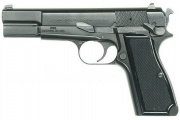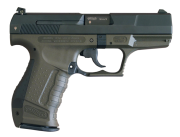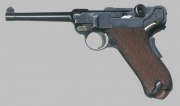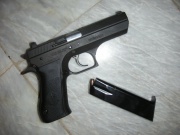Handgun
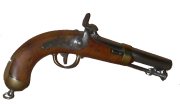

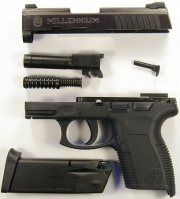
A handgun is, just like it sounds, a firearm designed to be held in the hand when used. This characteristic differentiates handguns as a general class of firearms from their larger cousins: long guns such as rifles and shotguns, mounted weapons such as machine guns and autocannons, and larger weapons such as artillery.
Some handgun subtypes include single-shot pistols, revolvers, semi-automatic pistols, and fully automatic, or machine pistols.
The overlapping variations in meaning of the words "pistol" and "handgun" are discussed below.
[edit] Nomenclature variations
[edit] Multiple senses of the word "pistol"
The word "pistol" is often synonymous with the word "handgun". Some handgun experts make a technical distinction that views pistols as a subset of handguns. In American usage, the term "pistol" refers to a handgun whose chamber is integral with the barrel, making pistols distinct from the other main type of handgun, the revolver, which has a revolving cylinder containing multiple chambers. However, Commonwealth usage makes no distinction at a technical level—"pistol" may refer to revolvers, semi-automatics, or muzzle-loading/cap-&-ball handguns. For example, the official designation of the Webley Mk VI was "Pistol, Revolver, Webley No. 1 Mk VI", and the designation "Pistol No. 2 Mk I" was used to refer to both the Enfield Revolver and the later Browning Hi-Power semi-automatic.
The first pistols were made as early as the 15th century, however the maker is unknown[1]. By the 18th century, the term came to be used often to refer to handheld firearms. Practical revolver designs appeared in the 19th century, and it was in that century that the (sometimes-observed) technical differentiation in usage of the words "pistol" and "revolver" developed.
[edit] Etymology of "pistol"
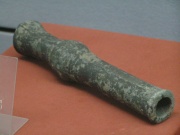
The word "pistol" is derived from the French pistole (or pistolet), which has these possible origins:
- From the Czech pistole and this one from the Czech píšťala (flute or pipe, referring to the shape of a Hussite firearm), via Middle High German pischulle and Middle French pistole.
- From the city of Pistoia, Italy, where hand-held guns (designed to be fired from horseback) were first produced in the 1540s.[2]
- That early pistols were carried by cavalry in holsters hung from the pommel (or pistallo in medieval French) of a horse's saddle.
[edit] Types of handguns
The general types of handguns are listed below in their order of historical appearance. Each type can be classified into many subtypes. Some of these types can also be differently classified using the general distinction between muzzle-loading firearms (loading from the front of the barrel) and breech-loading firearms (loading from behind the barrel).
[edit] Single-shot pistols

Single-shot pistols are the theoretically simplest pistols. The earliest handguns were single-shot, muzzle-loading guns with ignition provided by inserting a smoldering match cord into a touch hole. As such, they were essentially nothing more than miniature cannons, small enough to be handheld.
Improvements followed in subsequent centuries, as various types of locks (ignition devices) were invented. In the matchlock, the separate match cord was affixed to a spring-loaded pivot which could be tripped by a trigger. In the wheellock, a mechanism analogous to that used in today's cigarette lighters replaced the smoldering match cord. In the 17th century, the flintlock, which strikes a flint against steel, appeared. (The flintlock, amazingly, remained state-of-the-art for some two hundred years.) In the 19th century, percussion caps were developed, followed shortly by modern integrated-primer cartridges, and hammers therefore traded their flint for firing pins.
Single-shot pistols are not completely things of the past, as they have continued to be built (for various reasons) throughout the breech-loading era. However, for most applications, the single-shot handgun has been replaced by revolvers and semi-automatic pistols.
[edit] Multi-barreled pistols
Not long after the very beginning of firearms, inventors began experimenting with multi-barreled weapons in the quest for the ability to fire more than one shot before needing to reload. Not surprisingly, all types of firearms were included in their efforts, from volley guns to analogously devised handguns. Before anyone developed a practical capability for delivering multiple loads to one barrel in quick succession (which is how repeat fire is usually accomplished today), they were aggregating multiple loaded barrels into one place.
Some examples of such handguns are:
- Duck's-foot pistols
- Derringers
- Pepper-box guns (variously referred to as pepper-box pistols or pepper-box revolvers)
- Howdah pistols, often made from double-barrelled rifles.
[edit] Revolvers
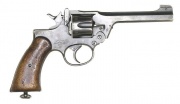
With the development of the revolver in the 19th century, gunsmiths had finally achieved the goal of a practical capability for delivering multiple loads to one handgun barrel in quick succession. Revolvers feed ammunition via the rotation of a cartridge-filled cylinder, in which each cartridge is contained in its own ignition chamber, and is sequentially brought into alignment with the weapon's barrel by a mechanism linked to the weapon's trigger (double-action) or its hammer (single-action). These nominally cylindrical chambers, usually numbering between five and ten depending on the size of the revolver and the size of the cartridge being fired, are bored through the cylinder so that their axes are parallel to the cylinder's axis of rotation; thus, as the cylinder rotates, the chambers revolve about the cylinder's axis.
There is a hybrid form of the revolver, known as the automatic revolver, which combines the revolving chamber concept of the conventional revolver with the recoil-harnessing, self-cycling ability of the semi-automatic pistol.
[edit] Semi-automatic pistols
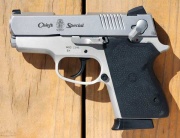
The next development in handgun history after a practical revolver was the development of the semi-automatic pistol, which uses the energy of one shot to reload the chamber for the next. Typically recoil energy from a fired round is mechanically harnessed, however larger calibers may also be gas operated (e.g. Desert Eagle). After a round is fired, the pistol will cycle, ejecting the spent casing and chambering a new round from the magazine, allowing another shot to take place immediately.
Some terms that have been, or still are, used as synonyms for "semi-automatic pistol" are automatic pistol, autopistol, autoloader, self-loading pistol and selfloader.
[edit] Machine pistols
A machine pistol is generally defined as a firearm designed to be fired with one hand, and capable of fully automatic or selective fire. While there are a number of machine pistols such as the Glock 18 and later models of the Mauser C96, these are rare; the light weight, small size, and extremely rapid rates of fire of a machine pistol make them difficult to control, making the larger and heavier submachine gun a better choice in cases where the small size of a machine pistol is not needed. Most machine pistols can attach a shoulder stock (the Heckler & Koch VP70 would only fire single rounds at a time unless the stock was attached); others, such as the Beretta 93R, add a forward handgrip. Either of these additions technically create a legal non-pistol under the US National Firearms Act, as pistols are by definition designed to be fired with one hand. The addition of a stock or forward handgrip is considered a design change that creates either a short-barreled rifle or any other weapon, and therefore such additions are generally only found on legal machine guns.
[edit] Operating mechanisms
Single-action (SA) handguns have a trigger whose sole function is to drop a pre-cocked hammer to discharge a cartridge. For revolvers, the popular Colt Peacemaker of Old West fame is typically thought of. Its hammer must be manually cocked for each shot. For auto-loading pistols the Colt 1911 or Browning Hi-Power are typical examples. They must be cocked for the first shot, but subsequent shots are cocked automatically due to the racking of the slide. These types of guns typically have a very light and crisp trigger pull, making for more accurate target shooting.
Traditional double-action (DA) handguns have a mechanism that can be either pre-cocked, like the above single-action gun, or can be fired with the gun uncocked. In this case, the gun has an additional mechanism added to the trigger that will cock the gun (and rotate the cylinder in the case of revolvers) as the trigger is pulled. Once the trigger is pulled far enough, the hammer is released and the gun fired. For autoloading pistols the self-loading mechanism will also re-cock the hammer after the first shot is fired so that subsequent shots are fired single-action. For revolvers, each shot is fired with the hammer initially uncocked unless the shooter manually cocked the gun. Popular auto pistols in this category include the Walther P38 and Beretta 92. These guns typically have a longer, heavier trigger pull for the first shot then light, crisp pulls for subsequent shots. Popular revolvers include the Ruger Redhawk and Smith & Wesson Model 629. These have comparatively long, heavy trigger pulls for all shots unless the revolver is manually cocked.
Double-action only (DAO) handguns do not have the ability to be cocked and is usually evidenced by a lack of either the hammer spur or the entire hammer. A typical autopistol in this category is the Ruger KP93DAO and Taurus Millennium, and a typical revolver is the Smith & Wesson Centennial. All pistols in this category have a long, heavy trigger pull for all shots.
Pre-set triggers are only on autoloading pistols. In this case the pistol mechanism is always partially cocked while being carried and during firing. The partially-cocked firing pin or striker is not cocked enough to cause an accidental release to discharge a cartridge, adding to the safeness of the design, but is cocked enough to remove much of the trigger pull and weight of a purely double-action pistol. These types of pistols do not have external hammers and do not generally have a decock function. Common pistols in the category are the Springfield Armory XD and the various forms of the extremely popular Glock. The trigger pull of these guns is between double-action and single-action pistols. Pre-set triggers may or may not have a second-strike feature on a dud cartridge.
Some automatic pistol models such as the HK USP Universal Self-loading Pistol come in a variety of mechanism types and can be easily changed by a gunsmith for both left- and right-handed shooters and for different operating mechanism and safety features.
Glock introduced a new "Safe Action" mechanism that is neither a single nor double action.[3] The action is not cocked, rather the firing pin is pulled back by the trigger, resulting in the first and subsequent trigger pulls all being the same and the weapon also being safer.
[edit] Semi-automatic pistols vs. revolvers
Both revolvers and semi-automatic pistols have prominent places in the world of handgun applications today. For over a century, however, a debate has continued as to which one is better for which particular application and why. Each has its place, although personal preference is as large a factor as the following variables:
- reliability (likelihood of jams; how to recover from jams; how to recover from misfires)
- degree of user training needed
- degree and frequency of gun cleaning needed
- ammo capacity
- speed and ease of reloading
- bulkiness with regard to concealment
- weight
- center of gravity
- storage issues
[edit] Advantages of revolvers
- Ease of use: Revolvers are truly point and shoot. No safeties or complex procedures inhibit putting a revolver into action. Semi-autos require several steps to place them into action, allowing room for error in critical situations.
- Reliability: Blockages and jams are virtually impossible in a revolver. A dud round is cleared by a simple pull of the trigger. Several types of blockages and jams are possible (and fairly common) in semi-autos. With semi-autos one must rack the slide, or possibly more extensive action to clear a jam, which takes the pistol out of the shooting position. See Tap Rack Bang.
- Ruggedness: Revolvers have a simpler, more rugged and robust design.
- More stopping power: The largest and most powerful handgun rounds are rimmed rounds for revolvers only, owing to their sturdier design.
- Revolvers will easily fire blank ammunition. Most semi-autos will not fully cycle with blank cartridges, causing jams. Semi-auto pistols must be specially modified to properly cycle with blank ammunition, as in the case of prop weapons for cinema. This modification renders them incapable of firing any other cartridge type.
- Spent cartridges are kept in the cylinder whereas a semi-auto ejects them. This is useful for reloaders.
- Storage: Revolvers and speedloaders can be stored loaded indefinitely with no issues. Semi-auto magazines have springs under tension when loaded. These springs may weaken and fail to load the cartridges effectively if the magazine has been stored loaded for long periods.
- More variety in ammunition: Revolvers can chamber virtually any cartridge, including wadcutters, which will jam a semi-auto. This makes revolvers more appealing to many sport shooters. Additionally, revolvers can load certain interchangeable cartridges, those with identical calibers but different case lengths. Interchangeable cartridges include .22 short/long/long rifle, .357 magnum/.38 special, .44 magnum/.44 special, and .45 Colt/.410 shotshells (on some, check first).
- Better Accuracy: Sights are mounted to a fixed barrel, theoretically allowing greater accuracy.
- Easier to determine if loaded: bullets in a loaded revolver are readily apparent. An unloaded semi-auto is often visually identical to a loaded one.
- Easier to clean and maintain: Revolvers have few exposed moving pieces and do not require disassembly. There is no risk of loss or breakage of pieces with a revolver. Semi-autos must be disassembled for cleaning, which may be difficult and risks losing or breaking vital pieces in the field or in darkness.
- Speedloaders: Speedloaders are quicker and easier to fill than magazines. Speedloaders and magazines load their weapons with comparable speed, but speedloaders are bulkier. Also see advantage under "Storage" above.
[edit] Advantages of semi-automatics
- Larger ammo capacity: semi-automatics typically carry 7 to 17 rounds; most revolvers carry only 6 rounds, although some carry 7, 8 or even up to 10 in .22 caliber. Some jurisdictions limit the magazine capacity on handguns to 10 rounds, largely negating this advantage in these places.
- Better combat reloading: Magazines, while slower and more difficult to fill, are simpler to place into operation and more ergonomic to carry than speedloaders.
- Quieter: With similar ammunition, a semi-auto is typically slightly quieter. Flash and noise can be suppressed. Noise and flash suppressors are ineffective in most revolvers due to noise and flash escaping the gap between the cylinder and the barrel.
- Less expensive ammunition: semi-autos often fire standard military ammunition, which is more readily available and cheaper thanks to extensive mass production. However, popular revolver cartridges such as .38 Special are comparable in their cost and availability to popular autoloading cartridges such as 9mm Parabellum and .45 ACP.
- Autoloaders have a significantly slimmer and easier to conceal frame as they do not suffer from the bulge produced by the revolver's cylinder.
- Some contemporary automatics are made of light-weight materials, (such as polymer) making them lighter and more comfortable to carry for long periods. Polymer frames are impractical on revolvers, and the weight savings would be minimal as the main sources of weight are the barrel and cylinder which cannot be polymer.
- The nature of most semi-auto's operation makes the trigger pull much easier after the first round is fired, allowing for quick and accurate follow-up shots. Revolvers will always have strong trigger pulls unless the hammer is cocked before each shot, which greatly slows the shooter's rate of fire.
- Most semi-autos incorporate an external safety switch, which is a visual and tactile cue that the weapon is safe. However, newer revolver designs have incorporated hammer blocks and other safety mechanisms making them as safe as comparable autoloaders, even without an external safety.
[edit] Advantages of handguns versus shoulder weapons
In comparison to longer guns such as shoulder weapons (rifles and shotguns), handguns are smaller, lighter, and easier to carry. Since firearms don't rely on the user's strength, they put weaker individuals on an equal defensive footing; when Colt produced the first practical repeating handgun, it gave rise to the saying "God created men, but Colt made them equal".
Since using a handgun only requires one hand, whereas long guns often require both, that leaves a handgun user with a free hand. One example of where this is an advantage is with tactical lights, where the light and handgun can be used independently or in coordination; weapon mounted lights, as used on long guns and submachine guns, don't allow the light to be pointed independently of the weapon.
Another important tactical consideration in the context of civilian self-defense is maneuverability. An attacker in close quarters with the defender could more easily wrestle a shoulder weapon's muzzle to a position where it is not covering him, or could more easily wrestle the gun away from the defender, whereas a handgun offers little to grab, and would be more likely to still be covering some portion of the attacker during the struggle.
[edit] Disadvantages of handguns versus shoulder weapons
Handguns are often considered self-defense weapons for use under 50 yards (46 m). While a handgun in the hands of an experienced shooter may be effective at distances greater than 50 yards (46 m), a handgun cartridge is much more limited in its energy capacity than many long gun cartridges.
Many rifles are able to achieve bullet velocities of over 3,000 feet (910 m) per second, but rounds for handguns are rarely capable of achieving velocities over 1,500 feet (460 m) per second. Thus, long guns are generally more powerful at any range, and especially more effective at longer ranges than handguns.
A shooter is generally able to achieve considerably greater accuracy with a long gun than with a handgun. This is due partly to the longer distance between the rear and front sights, partly due to a more stable hold attainable with a long gun, and partly due to the higher muzzle velocity, which reduces the bullet travel time and thus reduces external effects on the bullet such as gravitational drop and wind.
[edit] Handguns and gun politics
Many handgun models are easily concealed on a person—a trait that is useful both to people wishing to bear arms for self-protection and to criminals wishing to carry a handgun for illegal purposes. For these reasons, handguns are a particular focus of debates on gun politics, and in many jurisdictions their ownership is much more heavily regulated than that of long arms.
In the United States, the legal basis for the right of individuals to own handguns is the second amendment, a part of the U.S. constitution. The details, exceptions, and controversies relating to this are beyond the scope of this discussion. Legislation controlling how handguns are carried is the province of the state governments. Open carry is often prohibited, although not always. Most states (currently 48 of 50) allow some form of concealed carry by citizens meeting training or other requirements. 39 of these states, called "shall-issue" states, require issue of a permit if there is no compelling reason not to issue a permit (such as a prior felony conviction, a restraining order, or history of mental illness). Generally, in a shall-issue state, if a person cannot obtain a concealed weapons permit once training requirements are met, that person also cannot lawfully own a firearm. The remaining 9 states, called "may-issue" states, may deny a permit for any reason, usually at the discretion of local law enforcement. In the United States, a person must be 21 years of age to purchase a handgun or ammunition intended for a handgun from a federally licensed dealer, which is higher than the age requirement of 18 for rifles and shotguns.
In the United Kingdom and Ireland, civilian ownership of almost any handgun has been outlawed since the Dunblane massacre of 1996; the only exclusions were single shot, rimfire, and muzzleloading pistols; all cartridge firearms were later banned in 1997. Air pistols are still legal, however, those with energy levels over 6 foot pounds (8.1 joules) (half the limit for air rifles) are classified as firearms.[4][5][6]
Civilian ownership of handguns in Australia is legal, but heavily restricted. Handguns may not be owned for self-defense purposes (Target shooting, collecting, and occupational reasons for farmers/gun dealers are, by and large, the only legal reasons for handgun ownership), and anyone wishing to possess a handgun must obtain a firearms license and observe stringent storage regulations.
In Canada, ownership of handguns is restricted and subject to registration. Guns with a barrel length of 105 mm (about 4.14 inches) or less and handguns that fire .25 or .32 caliber ammunition are classified as prohibited. Some users are allowed to possess a handgun or rifle classified as prohibited (automatic and certain semi automatic firearms) if the firearm was owned and registered before the law came into effect on December 1, 1998. [7]. A Possession and Acquisition or a Possession Only Licence is required to own all firearms. Permits to carry concealed weapons are rarely, if ever, granted to non-law enforcement personnel [8].
In Israel, handguns are the only type of firearms that most private citizens may own. They are licensed for self-defense purposes to eligible individuals. Current regulations limit licenses to one handgun and 50 cartridges per licensee.
In Pakistan, citizens in the Punjab and the Sindh are subject to strict gun control regulations and may only carry a gun as long as it is concealed, even if it is with a bodyguard. Also the display of armory in public was banned and is subject to fines of up to 50,000 Rupees. Citizens must also register the gun and obtain a license for it. Many classes of precision (such as sniper) rifles are banned - the more precise the gun the less chance you have of obtaining a licence. In Balochistan and NWFP, however most of the urban population owns a vast amount of automatic and sophisticated weaponry which includes the SVD Dragonov sniper rifle and semi-automatic weapons such as the HK MP5. The AK-74 assault rifle and Desert Eagle pistol are also in high demand. This upsurge is due to increased militant activity in NWFP's tribal areas with citizens looking for ways to protect themselves. These developments have led to tight controls on guns and heavy fines for even firing a single round at any time in a public area. An automatic FIR can be registered by the police if you are caught firing shots in the air; this is done to avoid stray bullets which may lead to someones death.
See the main gun politics article or the article on concealed carry in particular for more details on this debate.
[edit]
In the 1780s, Alessandro Volta built a toy electric pistol [9] in which an electric spark caused the explosion of a mixture of air and hydrogen, firing a cork from the end of the gun.
[edit] See also
- Blowback
- Concealed carry
- Gun
- Handgun effectiveness
- Machine-pistol
- Pocket pistol
- Small arms
- Semi-automatic pistol
- Antique guns
- Target shooting
- List of pistols
[edit] References
- ↑ Pistol, Britannica.com
- ↑ The War Office (UK): Textbook of Small Arms (1929)', page 86. H.M. Stationery Office (UK), 1929.
- ↑ Glock Pistols August 20, 2003
- ↑ United Kingdom Air Rifle Law & Safety Reference
- ↑ [http://f4bscale.worldonline.co.uk/gunlaw.htm Safety and the Law in the U.K.
- ↑ Air Rifles Code of Practice (revised July 2007)
- ↑ RCMP fact sheets on firearms
- ↑ Canadian Firearms Centre paper comparing Canadian and American gun laws
- ↑ VOLTA's INSTRUMENTS: ELECTRIC PISTOL
